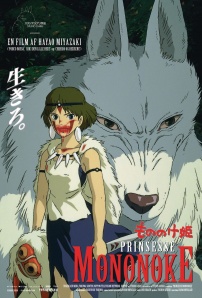The film, Princess Mononoke, is set in a world reminiscent of historical Japan with elements of fantasy: demons exist and gods are in the form of large animals. It is a fantasy film that follows the quest of Prince Ashitaka as he attempts to remove the curse that was placed on him by a boar demon. Forced to leave his home, he comes across a settlement called Iron Town, in which the head, Lady Eboshi, and a wolf-girl named San, are at odds with each other. Iron Town needs the forest in order to make their living; however, San does not like the human presence in the forest and tries to protect it. Prince Ashitaka finds himself in the midst of this conflict.
Analysis
The environment is the overlying theme in this film. The conflicting visions of the forest gods and Iron Town and their inherent inability to coexist reflect the real life struggles of society to live peacefully alongside nature in an increasingly industry-driven, technological world. The effects of human settlement and industry on nature in the film are seen starkly in the suffering of the forest gods. Some are driven mad with hatred and resentment, and become demons.
Iron Town symbolizes industry, expansion, human growth, ambition, and greed. Lady Eboshi is a very driven, ambitious head of Iron Town. She sees the forest as a means for human expansion and industry. Her actions upset the forest gods, who are negatively affected by the human presence in the forest. San and the gods of the forest want to eliminate human presence from their forest completely. They only see negative things in humans and are blinded by their hatred for them. Ashitaka, as an outsider, is unbiased by either side in the conflict. He sympathizes with both sides and also sees the errors of their ways. He eventually helps them to coexist, but not before a heavy price is paid for human greed- the death of the Forest Spirit, the entity that the very wellbeing of the forest depends on. The Forest Spirit’s death is destructive not only to the forest, but to the town that depends so heavily on the forest for its industrial growth.
Man and nature slowly learn to peacefully coexist as both attempt to rebuild and recover from the destruction wrought by the Forest Spirit’s death. The film ends on a hopeful note, showing that coexistence between man and nature is possible despite the worst of circumstances.
Conclusion
Princess Mononoke contains a very environmentalist message; despite how dark the film gets at times, it shows the audience that man and nature are able to coexist peacefully. It doesn’t attempt to demonize humans; although Lady Eboshi is shown to be ambitious and greedy, she is a multi-faceted character and has compassion for her fellow humans (as seen when she cares for the lepers who would otherwise have no chance at a life). As humans are not portrayed as the “bad guys”, the forest gods aren’t shown to be perfect, either. They are subject to the same flaws of humanity; like humans, they are short sighted and they are blinded by their hatred for humanity.
Princess Mononoke sets itself apart from other films with the same message by not attempting to pin the roles of the villains and the “good guys” on either side. Both sides have their redeeming qualities, but they are flawed. Both sides are capable of coexisting peacefully with the other; there is no “good side” or “bad side”.
References
Miyazaki, H. (Director). (1997). Princess Mononoke [Motion Picture]. Japan: Studio Ghibli


I think all of the Studio Ghibli films I have watched had a strong environmentalist message….have you had the same experience?
Yes, I have. I think it’s really interesting how such environmentalist themes are especially prevalent in Hayao Miyazaki’s films, although it’s not surprising. Hayao Miyazaki is a pretty big environmentalist.